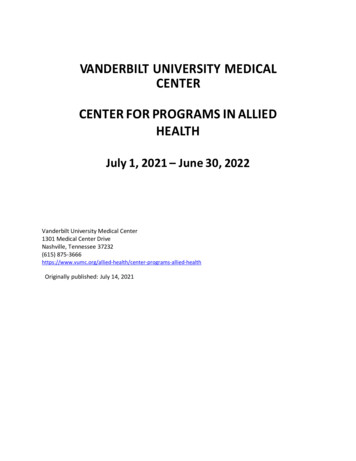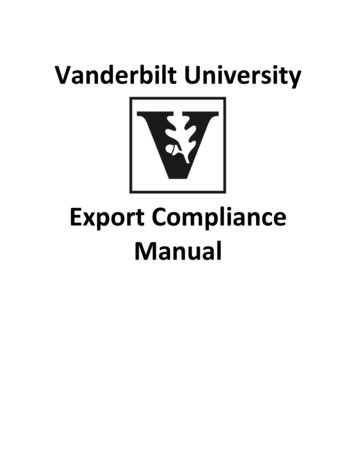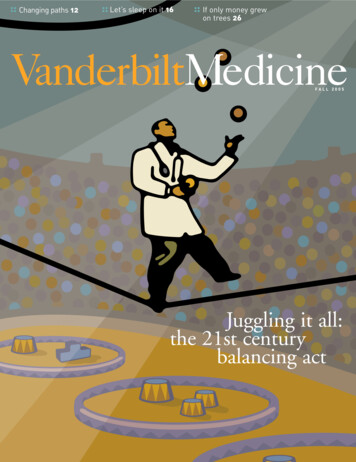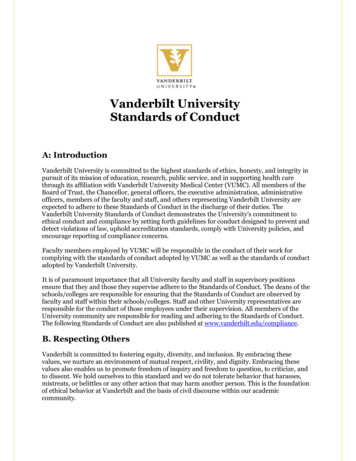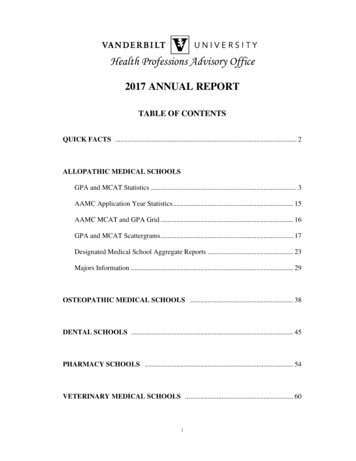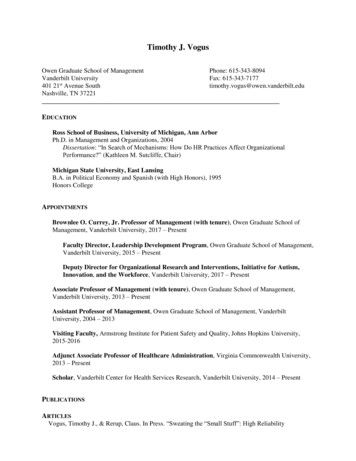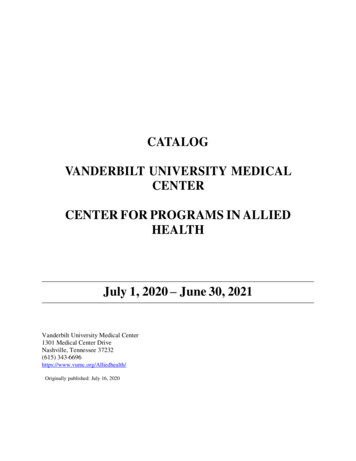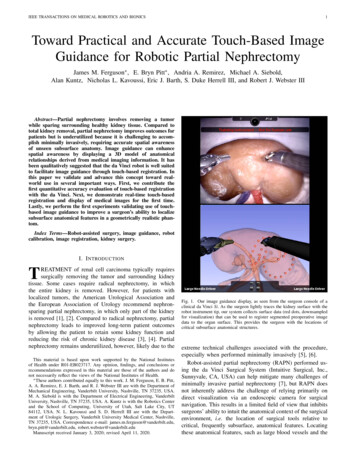
Transcription
C E ECIVIL AN DE NVIRON M E NTALE NG IN E E RINGATVA N D E R B I LTU N I V E R S IT ustainableconcreteResilientinfrastructure56811
NashvilleVanderbiltCornelius Vanderbilt had avision of a place that would“contribute to strengtheningthe ties that should existbetween all sections of ourcommon country” when hegave a million dollars to createa university in 1873. Today,that vision has been realized inVanderbilt, an internationallyrecognized research universityin Nashville, Tennessee, withstrong partnerships amongits 10 schools, neighboringinstitutions and the community.Vanderbilt offers undergraduateprograms in the liberal artsand sciences, engineering,music, education and humandevelopment, as well as afull range of graduate andprofessional degrees. Thecombination of cutting-edgeresearch, liberal arts education,nationally recognized schoolsof law, business and divinity,the nation’s top rankedgraduate school of educationand a distinguished medicalcenter creates an invigoratingatmosphere where studentstailor their education to meettheir goals and researcherscollaborate to address thecomplex questions affecting ourhealth, culture and society.Vanderbilt’s hometown of Nashvilleis a vibrant, engaging city knownproudly as “Music City, U.S.A.” andone of the fastest growing areas inthe Upland South. The university’sstudents, faculty, staff and visitorsfrequently cite Nashville as one ofthe perks of Vanderbilt, with its 330acre campus located a little morethan a mile from downtown.Nashville’s downtown areafeatures a diverse assortment ofentertainment, dining, culturaland architectural attractions. TheBroadway and 2nd Avenue areasfeature entertainment venues andan assortment of restaurants. Northof Broadway lie Nashville’s centralbusiness district, Legislative Plaza,Capitol Hill and the TennesseeBicentennial Mall. Cultural andarchitectural attractions are foundthroughout the city.Named America’s friendliest citythree years in a row, Nashville isa metropolitan place that exudesall the charm and hospitality oneexpects from a Southern capital.Fortune magazine named Nashvilleone of the 15 best U.S. cities forwork and family. It has ranked asthe No. 1 most popular U.S. city forcorporate relocations by ExpansionManagement magazine, and namedby Forbes magazine as one of the25 cities most likely to have thecountry’s highest job growth overthe coming five years. GQ posted anarticle dubbing the city “Nowville.”The New York Times has declaredNashville a new “it” city. We’reNo. 3 in Travel Leisure’s America’sBest Cities.The city proper is 526 squaremiles with a population of nearly659,000. The 13-county metropolitanarea population is more than1.7 million, making it the largestmetro statistical area in Tennessee.Major industries include tourism,printing and publishing, technologymanufacturing, music production,higher education, finance, insurance,automobile production and healthcare management.Nashville is comfortable andaffordable, beautiful and friendly.When we say, “Welcome toNashville,” we mean it.An independent, privatelysupported university, Vanderbiltis the largest private employerin Middle Tennessee and thesecond largest private employerbased in the state.Cover: Kirkland Hall, with its iconic tower, is the main Vanderbilt University administration building.Above: The Cumberland River, flanked by Cumberland Park in East Nashville and the ever-changing downtown skyline, winds through much of the city.Right: Vanderbilt’s tree-filled campus is a short drive from a dynamic urban center. Photos: John Russell/Vanderbilt
CEECIVIL AND ENVIRONMENTAL ENGINEERING AT VANDERBILT UNIVERSITY 2019-2020Civil and Environmental Engineering at Vanderbilt School of Engineering provides a distinct, worldclass experience. We combine state-of-the-art facilities with the intimacy and faculty contact ofa small private university. In the last five years the department has hired multiple young facultymembers – experts in hydrology, membrane fabrication, transportation, computational science andresilience engineering – and their reasons for choosing Vanderbilt are remarkably similar. The CEEdepartment, they say, is unusually innovative, extremely collaborative and highly supportive. “Theysay, ‘Your success is our success,’” one new professor recalled. “And they mean it.” We do mean it,whether you are a new professor, an undergraduate or a graduate student. We invite you to pushtraditional boundaries, work across department, school and institutional lines, and grapple withgrand challenges that will shape our future.Vanderbilt UniversitySchool of EngineeringVanderbilt University School ofEngineering is internationallyrecognized as a leader in engineeringresearch and education. Its facultyexpertise and graduate programs areaimed at solving complex societalproblems through collaborationsamong the disciplines and acrosscampus. That culture of collaborationprovides endless opportunitiesfor students and faculty from alldisciplines to work in any of our ninecore competencies.We call these areas intellectualneighborhoods – risk, reliability andresilience; cyber-physical systems;energy and natural resources;nanoscale science and engineering;big data science and engineering;regenerative medicine; rehabilitationengineering; biomedical imagingand biophotonics; and surgeryand engineering.Table of Contents234568Undergraduate programs of studyGraduate programs of studyPreparing civil engineers for a complex futureImmersive design opportunitiesCivil Infrastructure & Systems EngineeringEnvironmental Materials & Durability91011121416Nuclear Environmental EngineeringWater Resources, Quality & TreatmentMaterials and Structural EngineeringResilience and Sustainability18192021Centers and institutesFacultySelect honors and awardsAdmissions and financial aidUndergraduate opportunitiesLaboratories1
PROGRAMS OF STUDYUNDERGRADUATEVanderbilt’s B.E. in civil engineering prepares graduates to begin exhilaratingcareers in one of the many specialty areas of civil engineering, includingenvironmental and infrastructure sustainability, structural engineering andgeneral civil engineering or to pursue a successful career in areas such asbusiness, law or construction management.The Vanderbilt School ofEngineering offers a Bachelor ofEngineering in Civil Engineering.Environmental Engineeringis considered a sub-disciplinewithin the Civil Engineeringdegree program.Big challenges await civil andenvironmental engineers: smartand sustainable communities,autonomous vehicles, waterresources development andsecurity, environmentalrestoration among them. Civilengineers account for the mostjobs of any engineering field,and hiring outpaces job postingsin this field.Advanced materials,environmental engineering,sustainability and data scienceare themes that cut across ourcivil engineering curriculum.The rich curriculum ensures abreadth of coverage that equipsstudents with the tools necessaryto be successful in virtually anyarea of civil engineering practiceor graduate study. Areas includestructural mechanics and design,transportation, geotechnical,environmental and waterresources experiences.2The undergraduate programalso allows room for customtailoring. For example, a studentinterested in sustainabilitycould take Sustainable Designin Civil Engineering as asophomore and Energy SystemsEngineering during senior year.Students interested in intelligenttransportation and the ability ofcommunities to bounce back froma hurricane or other disasterscould take Risk, Reliability, andResilience Engineering as juniorsand Infrastructure SystemsEngineering the next year.Immersion experiences –including research projects,internships and study abroadopportunities – take studentsout of the classroom as theywork together with their facultyadvisers to answer importantquestions with immediate andlong-term impact.Many civil engineering studentsalso gain additional depth andbreadth of knowledge throughthe election of a minor. Themore popular minors includeEngineering Management,Mathematics, Economics, Energyand Environmental Systemsand Computer Science. A minorin Environmental Engineeringis also available to all non-civilengineering students.Yes, Vanderbiltengineering studentsdo study abroadYou can choose from more than 25programs in engineering in locationsranging from Dublin to Sydney toHong Kong. Engineering study abroadopportunities include exchangeprograms with Budapest Universityof Technology, City University ofHong Kong, Hong Kong Universityof Science and Technology, NationalUniversity of Singapore, Politecnicodi Torino and more!Financial aid applies to study abroadduring the academic year andscholarships are available to supportsummer study abroad. Studentsshould discuss with their academicadvisers how best to incorporatestudy abroad into their four-year plansof study. Check out Vanderbilt’s GlobalEducation Office (vanderbilt.edu/geo)for more information.Irfaan KhalidEngineering, 2019Studying abroad at Hong Kong University ofScience and Technology
PROGRAMS OF STUDYGRADUATECEECivil and environmental engineering graduate students collaborate with ourfaculty to make a positive impact on society in work that spans the countryand the globe. Investigating nuclear power plants in the U.S., reliabilityof aircraft above us, and water security all around us, they develop themethods and technologies to ensure a safe, cost-effective, reliable andresilient world, both built and natural.Graduate study here providesstudents a unique experience ina world-class setting with theintimacy and faculty contact ofa small private university. Stateof the art facilities for combiningcomputational and experimentalinvestigations include theEnvironmental EngineeringLabs, featuring advancedinstrumentation for microscopyand analytical chemistry, and theLaboratory for Systems Integrityand Reliability, featuring realisticscale engineered systems fromnuclear power plant cooling circuitsto aircraft structural testing.Areas of concentration forgraduate students include: Civil and Infrastructure SystemsEngineering Materials and StructuralEngineering Environmental Materials &Materials Durability Nuclear EnvironmentalEngineering Resilience & Sustainability Water Resources, Quality, &TreatmentOur students collaborate closelywith researchers in otherdepartments and institutes atVanderbilt University, includingthe Multiscale Modeling andSimulation research facility,the Institute for SoftwareIntegrated Systems, the DataScience Institute, the Institute forNanoscale Science and Engineeringand the Vanderbilt Institute forEnergy and Environment. We haveongoing international projectsin Bangladesh, Sri Lanka, India,The Netherlands and Hong Kong,among others.Examples of recent Ph.D. workinclude study of groundwatersurface water interactions inBangladesh, a project that ledto an illustrated children’sbook in both English and theBangla language; computationalinvestigation of interfacemechanics of calcium-basednanocomposites; uncertaintyquantification methods across arange of applications, which ledto internships with Los Alamosand Sandia National Labs; anddeveloping gold nanoparticlesto identify defects in 3Dmanufactured components.The Department of Civil andEnvironmental Engineeringalso offers professional masterof engineering programs. TheM.Eng. in Civil Engineeringinvolves advanced trainingin Construction Managementand emphasizes three primaryareas: healthcare construction,commercial construction andproject delivery systems.The M.Eng. in Risk, Reliabilityand Resilience Engineering isa multidisciplinary program inwhich students focus on oneof several sectors, includinginfrastructure, defense systems,energy and environment,transportation and medicine.The professional degree programsare administered by the School ofEngineering. The M.S. and Ph.D.programs are administered by theVanderbilt University GraduateSchool. Please see the inside backcover for admissions and financialaid information, including pointsof contact for each program.3
CURRICULUM IMMERSION“Our engineers learn not only the basics of engineeringdesign but also the social and economic skills to crossdisciplinary boundaries and solve major global problems.”Doug AdamsDaniel F. Flowers Professor and Chair of the Department of Civil and Environmental EngineeringPreparing civil engineersfor a complex world andan exciting futureThe civil engineering module, takenas part of Introduction to Engineeringin the first year, sets the tone for ourhands-on curriculum. New studentsuse 3D printers and other techniquesto imagine and build new kinds ofrotor blades that capture as muchenergy from the wind as possible,testing them in a large-scale lab. Ina separate intro module, first-yearstudents design and build smallhydro-powered dams, usingenvironmentally friendly concrete.“The engineering curriculumcontinues with these kinds ofexperiences all four years,” said DougAdams, Daniel F. Flowers Professorand Chair of the Department of Civiland Environmental Engineering. “Ourcurriculum is designed to motivateand inspire students from the outset.”Sustainability is a major theme,and we recently expanded ourundergraduate program to includenew courses: Sustainable Design inCivil Engineering (sophomore year),Risk, Reliability, and ResilienceEngineering (junior year), andInfrastructure Systems Engineeringand Energy Systems Engineering(both in senior year).Sustainable Design in CivilEngineering is a required course forsophomores. In it, student teamshave used design-thinking projectsto reduce construction waste inpartnership with Nashville buildersand to make the Vanderbilt campusitself more sustainable.“We wanted to give students a visionfor the impact they can have on theirenvironment early in their collegecareer,” said Lori Troxel, professor of4the practice of civil and environmentalengineering, who teaches the course.Classic civil engineering courses havealso been modernized. Fluid Dynamicsis one example. Students take thecourse as juniors but at Vanderbilt,in addition to lectures and labs,they work in teams of four to designwater slides for a theme park. Theproject culminates with the creationof 3D printed models of the waterslides and a competition judged byrepresentatives from the NashvilleShores Waterpark.CEE undergraduates select fromthree areas of specialization withincivil engineering: Environmentaland Infrastructure Sustainability,Structural Engineering andGeneral Civil Engineering featuringautonomous cars and transportation.As seniors, students work in teams ondesign projects during their final twosemesters as undergraduates.Real-world experiences areincorporated in classrooms, labs,field tests, research projects,internships and study abroadopportunities as students learn theprinciples that underlie engineeringproblem solving.“Our students study engineering hereand they also learn the socioeconomicand human dimensions that canmake engineering solutions work forsociety,” Adams said. “I think this is adistinguishing feature of Vanderbilt’sengineering program. Our graduatesbecome leaders who not only analyzebut can help to realize these kindsof societal solutions working acrossdisciplinary boundaries.”
data for traffic studies and developednano-scale materials for nuclearpower plants that change color tosignal a warning. They’ve quantifiedflood-related traffic vulnerabilitiesand evaluated flood resilience inrural Tennessee counties. Projectshave investigated nano-modifiedconcrete for nuclear waste storageand how cars equipped with adaptivecruise control affect traffic flow.As part of Nashville’s partnershipwith Vanderbilt in smart citiesresearch, students work with facultywho study intelligent transportationsystems and how to address thecity’s challenges in flood protection,congestion, emergency managementservices and other areas.Outside the classroom, undergraduates dive deepinto design and researchAn immersion experience is a newVanderbilt University graduationrequirement, and civil engineeringstudents have many immersionopportunities.Nashville transit hub, water qualityimprovements in two Guatemalavillages and a modular watersystem for a living building are afew examples.Design as an Immersive VanderbiltExperience (DIVE) is one of them.DIVE projects teach humancentered design thinking whileworking on complex, real-worldproblems. Students developcritical thinking skills and work inmultidisciplinary teams.Opportunities abound. Our professorshave ongoing global projects inBangladesh, Israel, China, HongKong, The Netherlands, the U.K.and Colombia. Students also canget involved in mentored researchprojects, industry internships, andStudy Abroad placements, which alltake engineering undergraduatesout of the classroom and intoexperiences that build professionaland interpersonal skills.Engineering students have longparticipated in collaborative classworkand Senior Design projects that offerthe chance to make a big impact onsociety. Designing boat kiosks withpower generation for the CumberlandRiver, infill housing above a proposedMany undergraduates take advantageof paid, 10-week summer researchprojects. They’ve captured and parsedAnother living laboratory for ourstudents and professors is SterlingRanch, a new community southwestof Denver focused on sustainability,including smart managementsystems for water and energy.As part of the School of Engineering’spartnership with Sterling Ranch,one Senior Design team developed asolar powered device prototype thatremoves salt from groundwater toalleviate drought and provide purifiedwater. This group won an EPA P3award. A separate team was selectedas a finalist in the U.S. Departmentof Energy’s Race to Zero competitionfor designing a single family homethat produces more energy thanit consumes.“A place for research that’s of thismagnitude and this cutting edge iscompletely in line with Vanderbilt’sideals of immersion learning andvertical integration,” said CorneliusVanderbilt Professor of EngineeringDavid Kosson.5
Civil Infrastructure & Systems EngineeringNASHVILLE SERVES AS IDEALTEST BED FOR TRANSPORTATION,INFRASTRUCTURE ENGINEERSNot all roadslead throughNashville, but threeinterstates do,plus major freightrail lines and rivershipping lanes. Theregion’s populationis growing rapidly. Ride share andscooter services are booming.So is transportation andinfrastructure research.As sensing technologies,modeling, cyber-physical systems,data analytics and computationalpower advance, Vanderbilttransportation engineers have inGreater Nashville a dream test bed.“The convergence of technologyand transportation providesnew opportunities to designtransportation services that aresmart, sustainable, resilient, andefficient,” said Dan Work, associateprofessor of civil and environmentalengineering. “We are extremely wellpositioned to help graduate studentsdevelop real solutions to ourtoughest transportation problems.”Research includes collaborationswith Nashville, Memphis, Chattanoogaand the state Department ofTransportation. USDOT, DOE, NSF aswell as private industry are fundingsignificant efforts.The Department of Civil andEnvironmental Engineering alsohosts the Vanderbilt Center forTransportation and OperationalResiliency, which emphasizesintegration of transportationengineering, planning andmanagement. A VECTOR team ledby Mark Abkowitz, professor of civiland environmental engineering, andCraig Philip, VECTOR director, helpedsecure a 4.5 million, three-yearfederal grant to encourage greateruse of sustainable travel optionsamong the Vanderbilt community.6With the university’s match,the 9 million total will fund shuttleoperations, shuttle shelters, bikeshare shelters and other efforts.The first phase—installing sensorsacross the campus—is underway andwill make Vanderbilt “a preeminentuniversity testbed for managingmobility and improving air quality,”Work said.The grant is through the federalCongestion Mitigation and AirQuality Improvement program.The university and VanderbiltUniversity Medical Center’s jointstatus as Middle Tennessee’s largestemployer presented a significantopportunity to expand a leadershiprole in addressing congestion andair quality, according to Abkowitzand Philip.Since it began in 1988, VECTORhas developed ground-breakingapplications of informationtechnology, risk management andsystems thinking. Current researchfocuses on advanced informationsystems, intermodal freight, incidentdamage and emergency operations,smart cities and climate change,among other areas.For example, Work, also anassociate professor of computerscience, and his group are: Exploring the interplay betweenautonomous vehicles and phantomtraffic jams as well as whethercurrent vehicle automationsystems will improve traffic ormake it worse Understanding extreme trafficevents using data analytics onmassive mobility datasets Building mathematical modelsand systems theory tools tounderstand complex, multi-modalurban traffic Developing data-driven methodsto improve network wide railroadoperationsTransportation researchprojects cross departmental lines,and Vanderbilt CEE graduatestudents also work with expertsin the Vanderbilt Institute forSoftware Integrated Systems, aglobal force in developing cyberphysical systems and building aninternational CPS community. Forexample, Senior Research ScientistAbhishek Dubey, also an assistantprofessor of computer science, leadsa new collaboration to leverage datasensors, data collection and machinelearning to optimize schedules ofChattanooga metro bus routes andreduce energy consumption at asystem-wide level.
RISK MODELING, DATAINTEGRATION DRIVE NASAAIR TRAVEL SAFETY PROJECTAdditionally, the VanderbiltInstitute for Smart Cities Operationand Research works with MetroNashville agencies to develop atechnical and policy platform inwhich to study, research and developsolutions to challenges—mobilityamong them—faced by the city andurban centers around the world.“This is a distinct time fortransportation research,” Work said.“Years from now, we will look backat the transportation technologiesbeing developed today and say,‘Everything changed.’ The future wasnot certain and it gave us the chanceto shape it.”Vanderbilt risk and reliability engineers are heavily involved in anambitious NASA effort to develop the next generation air safetysystem, a project that gives top academic centers and industrycollaborators a larger role in shaping best practices and translating theminto commercial use.The 10 million, five-year project involves integrating complex datasources that will be the future of air traffic management systems, dubbedNextGen NAS.“The project combines expertise in multiple disciplines—aeronautics,computer science, probability and statistics, human factors, datascience, and systems engineering,” said John R. Murray Sr. Professor ofEngineering Sankaran Mahadevan, professor of civil and environmentalengineering and leader of the Vanderbilt team.It also allows Mahadevan, a recognized pioneer in uncertainty andrisk engineering, to work with several people who trained under him atVanderbilt. Yongming Liu, Arizona State University professor of mechanicaland aerospace engineering and the lead project investigator. He is a formerPh.D. student of Mahadevan, as are two researchers—Barron Bichon, Ph.D.2011, and Erin DeCarlo, Ph.D. 2017—from Southwest Research Institute andOptimal Synthesis Inc., another collaborating partner.The objective is to develop analysis methods to improve aviationsafety and support real-time decision-making so unsafe events can becaught early and prevented from evolving into major incidents.One piece of the puzzle had the Vanderbilt team manually combingthrough about 2,000 accident reports involving passenger aircraftfrom 1982 through 2017 to classify the states, or flight phases, in whichaccidents happen and then classify the actual causes, Mahadevan said.That followed construction of diagrams of precise event sequences—human errors, equipment failures and weather effects—as they unfoldunder actual circumstances.“Air travel demand is expected to double in the next two decades,leading to increased congestion and possibilities for unsafe events. Manyfields of human activity are being rapidly transformed by the explosionof modern sensing, computing, machine learning and data sciencetechniques, and this project aims to harness these techniques to improveair travel safety,” Mahadevan said.7
Environmental Materials & DurabilityRE-ENGINEERING CONCRETEWITH SEAWATER ANDPOLYMER COMPOSITESAssociate ProfessorFlorence Sanchezand Michael Kosson,a graduate student inchemical and biomolecularengineering, examine asmall concrete structureas it is printed. TheGantry-type 3D printerand a nanoindenter, whichmeasures and tests minutevolumes of a material’smechanical properties,were purchased as part ofthe “Materials Durabilityand EnvironmentalResearch Facilities Hub,”a university-wide effortSanchez directs.When FlorenceSanchez refersto concrete asa pedestrianmaterial, shedoesn’t meanwe walk on it, though we do.Sanchez uses “pedestrian”because this infrastructureworkhorse is everywhere – sidewalks,roads, housing, office towers, bridges,ports, levees, shopping centers,parking garages, curbs, suburbandriveways. Concrete is easy to takefor granted and most people do.Sanchez, associate professor ofcivil and environmental engineering,is not most people. That’s why shehas a key role in a major internationalproject to revolutionize productionof concrete using seawater, seasand and fiber-reinforced polymercomposites.8She is a co-principal investigatoron a 6.7 million grant from theHong Kong Research Grants Councilto a multi-university team of expertsin materials science, chemistry, civilengineering, material deterioration,complex modeling and otherspecialties. Researchers fromeight countries are involved in theambitious effort, funded by HongKong’s equivalent of the NationalScience Foundation. The five-yearproject also creates opportunitiesfor graduate student and facultyexchanges.The impact could be huge—concrete is the second most-usedsubstance in the world, behindwater. Concrete production isresource-heavy in raw materialsand costs to transport them, anddevelopment across the globehas created pressure to find moresustainable production options.With accelerated lab tests incontrolled environments and fieldexposure tests over a limited period,researchers will develop a lifecycle design methodology basedon multi-scale physics modeling ofmaterial and structure degradation.“This project combinesstructural engineering with materialsscience and applied research andfundamental science,” said Sanchez,an expert in molecular dynamicssimulation of composite materials,As deputy leader for oneof five primary project researchareas she will investigate how thematerials react with each other andtheir target environments at themolecular level.“Concrete is probably one ofthe most complex materials andone of the best to study,” Sanchezsaid. “We are surrounded by it butwe don’t see it, but without this wewouldn’t have infrastructure.”
Nuclear Environmental EngineeringADVANCING ENERGY, PROTECTING THEFUTURE. . . AND ADDRESSING THE PASTNuclear energy remains very much on the table as away to meet escalating demands for electric power, andVanderbilt’s expertise keeps environmental and safetyconsiderations at the forefront.Much has changed in the nuclear power industryover the last decade, said Steven Krahn, professorof the practice of nuclear environmental engineeringand a former deputy assistant secretary of energy forsafety and security in DOE’s Office of EnvironmentalManagement.An “astounding number of startup companies”pursuing next-generation molten salt reactor designs areamong the developments, Krahn said.Also, Congress in September 2018 passed theNuclear Energy Innovation Capabilities Act, tasking DOEto accept small experimental reactors at its sites forstudy. A related initiative provides federal money for nextgen nuclear power and requires national labs to have anindustry partner.Vanderbilt already has ongoing projects with OakRidge National Laboratory, DOE and industry partnersthat involve next-generational technology, includinggas-cooled fast reactors and molten salt reactors. Lightwater reactor technology has been the industry standard,however, neither the Nuclear Regulatory Commission norDOE are well-equipped to regulate newer technologies.That creates great opportunities in a growing fieldwith significant impact.The Vanderbilt NEE program encompassesassessment of new nuclear fuel cycles; risk assessmentprocedures for new reactor and process designs;laboratory methods for predicting the long-termenvironmental performance of systems for nuclear wastestorage and disposal; and treatment optimization ofwaste from nuclear weapons production.One Ph.D. student, for example, is crafting earlysafety assessment techniques for advanced non-lightwater reactors. Another is developing a mechanistic andquantitative understanding of how cement-like materialsage for low-activity nuclear waste disposal. A third isconducting accelerated aging tests on nuclear fueldry storage casks that are enhanced with new nanomaterials, using ORNL’s High Flux Isotope Reactor.The dissertation of two recent graduates comparedenvironment, health and safety characteristics of thoriumuranium and uranium-plutonium fuel cycles. One of thoseformer students is now an analyst at the National NuclearSecurity Administration. Other Vanderbilt graduates workfor the Nuclear Regulatory Commission and national labs.“Graduates of our program will be right there for thenext generation of nuclear power technology,” Krahn said.DOE-FUNDED CONSORTIUM PERFORMS HIGH-IMPACTRESEARCH IN NUCLEAR SAFETY AND CLEANUPGraduate students in nuclearenvironmental engineering haveextraordinary access to top peoplein the field—Vanderbilt hosts andmanages a large consortium thatadvises the DO
Financial aid applies to study abroad during the academic year and scholarships are available to support summer study abroad. Students should discuss with their academic advisers how best to incorporate study abroad into their four-year plans of study. Check out Vanderbilt's Global Education Office (vanderbilt.edu/geo) for more information.
